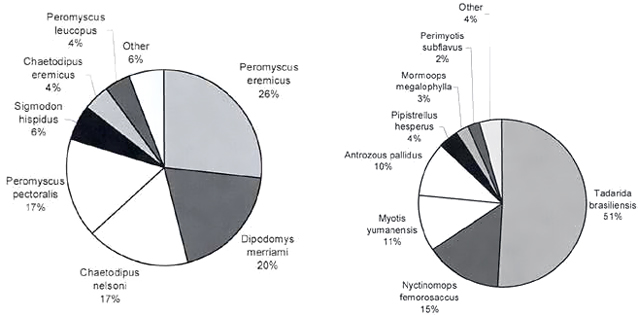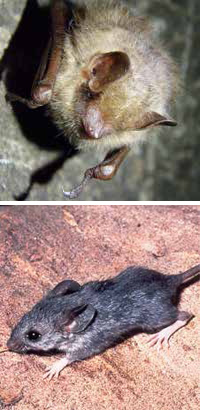The Rio Grande stretches from the mountains of southern Colorado to the Gulf of Mexico at the U.S.-Mexico border, a distance of approximately 1,885 miles. Much of the region through which this river flows is rugged, arid, and desolate. In 1978, Congress designated a 191-mile section of river as a part of the national Wild and Scenic River system.

NPS
This segment flows through an extremely rugged portion of the Chihuahuan Desert, from within Big Bend National Park (NP) downstream to the Terrell-Val Verde County line. The purpose of this study was to survey the mammals in selected riparian habitats along the Rio Grande from the eastern border of Big Bend NP in Brewster County, downstream through Terrell County. This section of the river flows through the rugged limestone canyons of the Stockton Plateau, and is commonly referred to as the Lower Canyons. Access to most of the Lower Canyons is limited to multi-day canoe trips.
Methods
Teams of biologists conducted surveys primarily through the Lower Canyons river corridor of the Rio Grande Wild and Scenic River (RIGR). Biologists conducted fieldwork from 3 September 2004 to 29 July 2005, including three 1-week float trips through the Lower Canyons. Vegetation along the river (riparian habitat) was dominated by the non-native giant reed, and the native common reed interspersed with small trees, including honey mesquite, willows, and non-native salt cedar. The researchers surveyed seven locations over multiple nights. Small mammals were surveyed at each of these sites with 100 small metal live traps (Sherman traps) placed along five trap lines (transects). These transects crossed through all unique habitats found at each site. Bats were captured live using fine nets (mist nets). In addition, bat vocalizations and echolocation (acoustic) data were recorded using Anabat detectors to supplement capture data. All observations of mammals and mammal sign, including visual observations, tracks, branch and tree cuttings by beavers, and gopher mounds were recorded. Cameras were set at some locations and sites were baited with various scents and smelly food (catnip, sardines). Gopher traps were used at some sites to verify the species of gophers present.
Results
Forty-three species of mammals were observed, captured, or seen on cameras. Species diversity was greatest in the Rodentia (rodent) family (n=17 species) and Chiroptera (bat) family (n=13 species). The only non-native species found was the nutria (Myocastor coypus).
Small Mammal Trapping
Small mammal traps were set on 35 nights. Twelve species of rodents and one western spotted skunk (Spilogale gracilis) were captured. The most common species captured were the cactus mouse (Peromyscus eremicus; 26%), Merriam’s kangaroo rat (Dipodomys merriami; 20%), Nelson’s pocket mouse (Chaetodipus nelsoni; 17%), and the white-ankled mouse (Peromyscus pectoralis; 17%).
Mist Netting
Mist nets were set on 19 nights. One hundred eighty-three bats representing 13 species were caught. The acoustic data recorded during mist netting documented some species much more effectively than the mist netting alone. The ghost-faced bat (Mormoops megalophylla) and western bonneted bat (Eumops perotis) were both easily detected using the Anabat detector. The most commonly observed bat was the Brazillian free-tailed bat (Tadarida brasilliensis; 51%). There was a significant drop in the number of observations with the next three most common species: pocket free-tailed bat (Nyctinomops femorosaccus; 15%), Yuma myotis (Myotis yumanensis; 11%), and Pallid bat (Antrozous pallidus; 10%).

Observations
Sixteen additional species of mammals were detected by direct observation, remote cameras, or sign. Species that were most effectively monitored this way were diurnal rodents, lagomorphs (cottontail rabbits and jackrabbits), carnivores, and artiodactyls (hoofed animals like deer).
Discussion

NPS
The results of this study support the observations of several other recent bat studies along the Rio Grande. Specifically, the eastern pipistrelle appears to have established itself throughout this region, and the pocketed free-tailed bat was more common than expected. Bobcat, mountain lion, white-nosed coati, ocelot, and black bear were documented infrequently or not at all with the methods used in this study. Hooved mammals were uncommon throughout the study area. The white-tailed deer (Odocoileus virginianus), which is considered primarily a species found in the eastern U.S., is continuing to expand its range westward, with a simultaneous contraction of mule deer (O. hemionus) range (primarily a species of the western U.S.). The mammal community appears relatively unaffected by non-native species or species primarily associated with humans. For example, no house mice (Mus musculus) were captured, and a single nutria was detected at only one site. Nutria were not found in the Trans-Pecos region 30 years ago, but now are common above and below the study area. Two other exotic species, feral hogs and aoudad that are quite common in the surrounding landscape, were not observed in this study. The rugged terrain, may effectively exclude feral hogs from many stretches of the river corridor. The mammals of the Lower Canyons of the Rio Grande have not been altered greatly by anthropogenic effects. The rugged nature of the region reduces the ability of livestock to graze the area, although goats have probably altered the vegetation in areas.
Reduced and occasionally complete cessation of river flows that now plague the Rio Grande through Big Bend National Park are mitigated to a great extent by springs that sustain a year-round flow through the Lower Canyons. Monitoring of this area should focus on key riparian species, specifically beaver and bats that appear to be abundant along the river. In addition, presence of non-native species should be monitored. The ruggedness of this area may protect the native mammals from the extent of changes often caused by anthropogenic effects. Any increased development to the river corridor, however, for example through border security initiatives, mining, or oil and gas exploration, will increase the risk of more substantial changes to the mammal fauna, and of potential introduction of more non-native species.
Prepared by the Chihuahuan Desert Network Inventory and Monitoring Program, 2013.
Last updated: November 30, 2016
